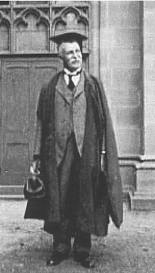
Edward J. Nanson
Encyclopedia

Mathematician
A mathematician is a person whose primary area of study is the field of mathematics. Mathematicians are concerned with quantity, structure, space, and change....
known for devising Nanson's method
Nanson's method
The Borda count can be combined with an Instant Runoff procedure to create hybrid election methods that are called Nanson method and Baldwin method.- Nanson method :The Nanson method is based on the original work of the mathematician Edward J...
, a variation of the Borda count
Borda count
The Borda count is a single-winner election method in which voters rank candidates in order of preference. The Borda count determines the winner of an election by giving each candidate a certain number of points corresponding to the position in which he or she is ranked by each voter. Once all...
using successive elimination down to the winner.
He was born in England
England
England is a country that is part of the United Kingdom. It shares land borders with Scotland to the north and Wales to the west; the Irish Sea is to the north west, the Celtic Sea to the south west, with the North Sea to the east and the English Channel to the south separating it from continental...
and received his professional education at Trinity College
Trinity College, Cambridge
Trinity College is a constituent college of the University of Cambridge. Trinity has more members than any other college in Cambridge or Oxford, with around 700 undergraduates, 430 graduates, and over 170 Fellows...
from 1870 to 1874. In 1875, he was appointed Professor of Mathematics at the University of Melbourne
University of Melbourne
The University of Melbourne is a public university located in Melbourne, Victoria. Founded in 1853, it is the second oldest university in Australia and the oldest in Victoria...
, in the state of Victoria
Victoria (Australia)
Victoria is the second most populous state in Australia. Geographically the smallest mainland state, Victoria is bordered by New South Wales, South Australia, and Tasmania on Boundary Islet to the north, west and south respectively....
, Australia
Australia
Australia , officially the Commonwealth of Australia, is a country in the Southern Hemisphere comprising the mainland of the Australian continent, the island of Tasmania, and numerous smaller islands in the Indian and Pacific Oceans. It is the world's sixth-largest country by total area...
where he immigrated. Nanson was an election reformer and office bearer of the Proportional Representation League of Victoria who produced several booklets on election methods. He retired from his lifetime appointment in 1922. At the time of his death, he was survived by ten children from two marriages. The Professor Nanson Prize was named in his honour, which is annually awarded to students for outstanding achievements in pure and applied mathematics.
Footnotes
- "Methods of Election" Transactions and Proceedings of the Royal Society of Victoria, vol. 18; 1882; pages 197-240; #954.
External links
- Australian electoral reform and two concepts of representation An article discussing Nanson's work by Iain McLean.
- Proportional Representation Text of pamphlet by Nanson.
- Professor E. J. Nanson's death National Library of Australia's digitised Australian Newspaper article

